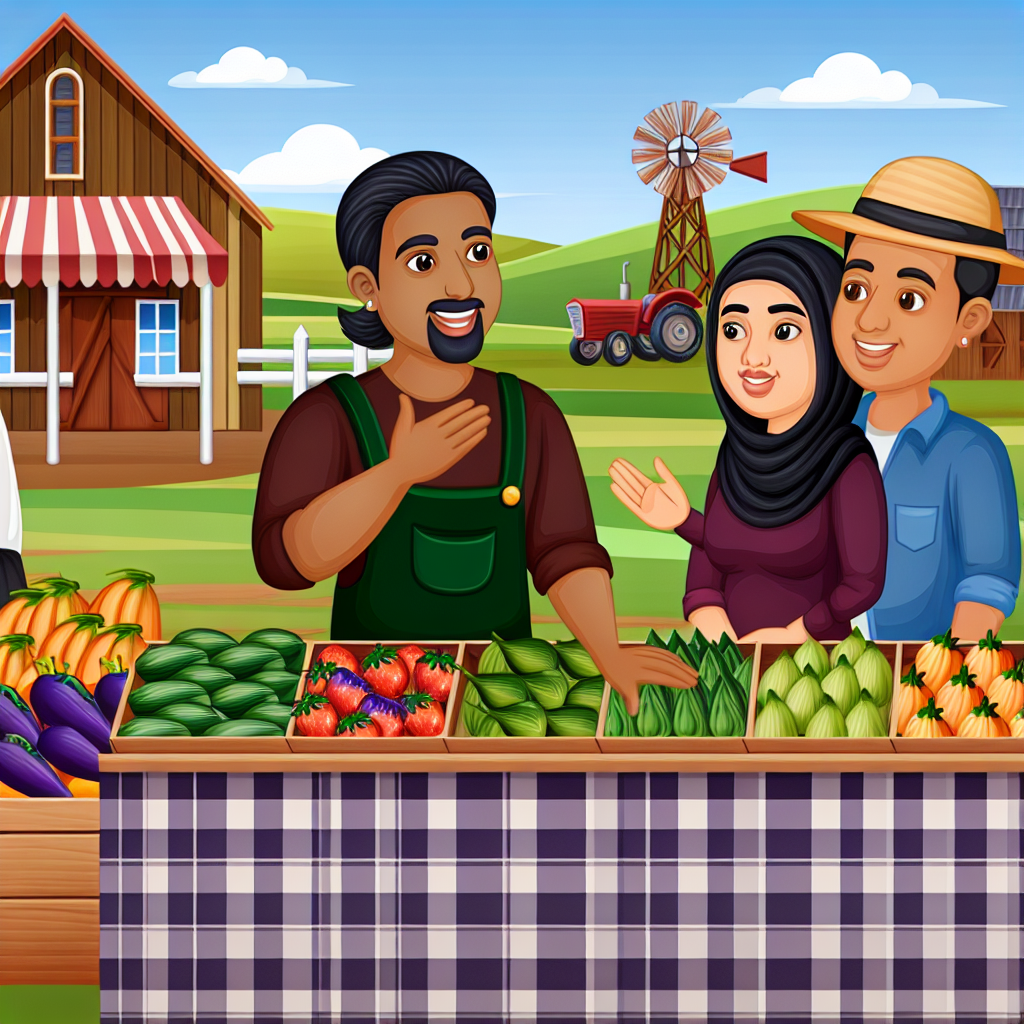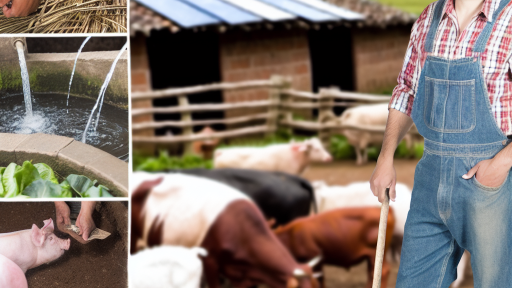Understanding the Importance of Local Food Systems
The Role of Local Food Systems
Local food systems connect farmers directly to consumers.
They enhance community relationships and support local economies.
Additionally, these systems promote sustainable agricultural practices.
Benefits for Farmers
Farmers benefit from direct access to customers.
This access reduces transportation costs and increases profit margins.
Furthermore, local sales allow farmers to receive immediate feedback.
This feedback helps them adapt products to meet consumer preferences.
Advantages for Consumers
Consumers enjoy fresh and seasonal produce through local food systems.
This food is often harvested at peak ripeness, enhancing flavor.
Moreover, buying locally reduces food miles and environmental impact.
It also fosters a sense of community support for local farmers.
Economic Impacts
Local food systems strengthen local economies significantly.
They create jobs in agriculture, distribution, and retail sectors.
Additionally, they help keep money circulating within the community.
This economic resilience leads to vibrant communities.
Transform Your Agribusiness
Unlock your farm's potential with expert advice tailored to your needs. Get actionable steps that drive real results.
Get StartedEnvironmental Benefits
Local food systems contribute to environmental sustainability.
They often utilize fewer resources than large, industrial systems.
Additionally, they can improve land use through responsible farming practices.
This focus on sustainability promotes biodiversity and ecosystem health.
Challenges to Local Food Systems
Several challenges affect the growth of local food systems.
Access to markets can be limited for some farmers.
Furthermore, large-scale operations often dominate the market.
However, community initiatives can help mitigate these challenges.
Strategies for Strengthening Local Food Systems
Community-supported agriculture (CSA) programs engage consumers directly.
Farmers’ markets provide a platform for local producers to sell their goods.
Additionally, local food cooperatives foster collaboration among farmers.
Education and outreach programs can further boost awareness.
Identifying Key Stakeholders
Connecting Farmers
Farmers are the backbone of the local food system.
They provide fresh produce and products directly to consumers.
Understanding their needs is crucial for effective connection.
Farmers want fair prices for their goods and reliable markets.
Building strong relationships with local consumers enhances profitability.
Understanding Consumers
Consumers increasingly seek fresh, locally sourced food.
They value quality, flavor, and sustainability in their purchases.
Identifying their preferences can help tailor offerings effectively.
Moreover, consumers are often willing to pay a premium for local products.
Engaging with consumers through surveys and feedback fosters loyalty.
The Role of Distributors
Distributors serve as vital links between farmers and consumers.
They facilitate the transportation and storage of agricultural products.
Showcase Your Farming Business
Publish your professional farming services profile on our blog for a one-time fee of $200 and reach a dedicated audience of farmers and agribusiness owners.
Publish Your ProfileEstablishing efficient distribution channels optimizes market access.
Cooperating with distributors can reduce logistical challenges for farmers.
This partnership ensures timely delivery of fresh produce to consumers.
Building Effective Networks
To connect effectively, stakeholders must collaborate actively.
Farmers can form cooperatives to increase collective bargaining power.
Consumers can support local farmers through community-supported agriculture.
Distributors should explore partnerships directly with local farms.
These networks enhance transparency and trust within the food supply chain.
Utilizing Technology to Bridge the Gap
Apps Empowering Farmers
Mobile applications have transformed the way farmers connect with consumers.
For instance, Farmigo facilitates direct sales between farmers and buyers.
This platform helps farmers manage orders and streamline deliveries.
Moreover, LocalHarvest connects consumers with local farms for sustainable produce.
These apps enhance visibility and access for local growers.
Online Marketplaces for Direct Sales
Online marketplaces serve as valuable tools for farmers.
Platforms like Etsy and eBay allow farmers to sell homemade products.
Farmers’ markets have also migrated online, creating new avenues for sales.
These platforms increase market reach beyond conventional boundaries.
Social Media as a Communication Tool
Social media plays a crucial role in connecting farmers with consumers.
Farmers utilize platforms like Instagram to showcase their products.
This strategy builds a visual narrative that attracts potential buyers.
Furthermore, Facebook groups foster community engagement among local consumers.
Innovative Technology Solutions
Technological advancements promote efficiency in agricultural practices.
For instance, precision farming utilizes data analytics for better crop management.
Farmers can optimize yields using smart irrigation systems and sensors.
These innovations lead to more sustainable practices, benefitting consumers and producers alike.
Consumer Education through Technology
Consumer education is essential for fostering connection with farmers.
Many platforms provide educational content about local agriculture.
Webinars and online courses facilitate learning about sustainable practices.
These initiatives empower consumers to make informed purchasing decisions.
See Related Content: Climate Resilience In Sustainable Agricultural Practices
The Role of Farmers’ Markets in Community Engagement
Fostering Connections Between Farmers and Consumers
Farmers’ markets serve as vital platforms for local agriculture.
They allow farmers to directly sell to consumers.
This interaction fosters a sense of community and belonging.
Additionally, consumers gain access to fresh, seasonal produce.
Moreover, they can connect with the individuals who grow their food.
This transparency builds trust within the community.
Economic Benefits for Local Farmers
Farmers’ markets provide essential income for local farmers.
They cut out the middleman, maximizing profits for producers.
This boost in revenue strengthens local economies.
Furthermore, farmers can diversify their product offerings.
Showcase Your Farming Business
Publish your professional farming services profile on our blog for a one-time fee of $200 and reach a dedicated audience of farmers and agribusiness owners.
Publish Your ProfileThey often sell unique items that are not available in stores.
Overall, these markets contribute to economic sustainability.
Promoting Sustainable Farming Practices
Farmers’ markets often highlight sustainable farming techniques.
Consumers become more aware of eco-friendly practices.
Buying local encourages farmers to adopt more sustainable methods.
Such practices help protect the environment and enhance biodiversity.
As a result, farmers’ markets promote a healthier ecosystem.
Supporting Local Food Systems
Farmers’ markets strengthen local food systems in various ways.
They encourage community members to support local agriculture.
In turn, this reduces the carbon footprint associated with food transport.
Consumers also learn about the importance of seasonal eating.
This knowledge enhances overall community resilience.
Creating Educational Opportunities
Farmers’ markets often offer educational workshops and activities.
These programs teach consumers about nutrition and cooking.
They also provide insights into farming practices and sustainability.
Engaging the community in these activities fosters awareness.
Ultimately, education at farmers’ markets benefits everyone involved.
You Might Also Like: How Farms Supply Fresh Produce to Schools
Leveraging Social Media for Direct Marketing Strategies
Building an Engaging Online Presence
Farmers must create an engaging online presence.
They can achieve this through social media platforms.
Consistent posts help build familiarity with consumers.
Content should highlight unique aspects of their farms.
Visuals capture more attention than plain text.
High-quality photos can showcase fresh produce effectively.
Choosing the Right Platforms
Different social media platforms serve various audiences.
Instagram is perfect for visual storytelling.
Facebook allows for community building through groups.
Twitter can facilitate quick updates and news sharing.
Farmers should consider their target audience when choosing platforms.
Creating Authentic Connections
Authenticity is crucial for building consumer trust.
Sharing personal stories can create emotional connections.
Highlighting farm practices fosters transparency among consumers.
Responding to comments and messages enhances engagement.
Community interaction leads to loyalty and support.
Utilizing Targeted Advertising
Social media advertising reaches specific audiences effectively.
Farmers can target ads based on location and interests.
Promotions can boost local sales significantly.
Utilizing tools like Facebook Ads helps track success.
Analytics guide future marketing strategies effectively.
Engaging in Collaborations
Collaborations with local businesses can expand reach.
Showcase Your Farming Business
Publish your professional farming services profile on our blog for a one-time fee of $200 and reach a dedicated audience of farmers and agribusiness owners.
Publish Your ProfilePartnering with restaurants can showcase local ingredients.
Joint events with other farmers enhance community involvement.
Shared promotions can attract a wider audience base.
Collaboration benefits all parties involved substantially.
Encouraging User-Generated Content
User-generated content is a valuable marketing tool.
Consumers sharing their experiences promotes organic reach.
Encouraging customers to tag the farm in posts builds community.
Contests and giveaways can incentivize sharing.
This approach enhances online visibility and engagement significantly.
Tracking and Analyzing Results
Monitoring social media performance is essential.
Farmers should analyze engagement metrics regularly.
Understanding what content resonates guides future efforts.
Adjusting strategies based on analytics fosters growth.
Consistent tracking can lead to improved marketing effectiveness.
Delve into the Subject: Educational Benefits of Farm-to-School Initiatives
Educational Initiatives: Teaching Consumers About Local Produce
Importance of Understanding Local Produce
Educating consumers about local produce enhances their buying choices.
This knowledge strengthens community ties and supports local farmers.
Additionally, informed consumers contribute to a sustainable food system.
Creating Community Workshops
Hosting workshops can effectively engage the community.
Farmers can demonstrate growing techniques and seasonal produce.
Interactive sessions allow participants to ask questions and share experiences.
Furthermore, workshops can highlight the nutritional benefits of local food.
Utilizing Social Media and Online Platforms
Social media plays a vital role in educating consumers.
Farmers can share recipes, tips, and information about their produce.
Online platforms can facilitate virtual tours of local farms.
This approach can engage a broader audience beyond conventional methods.
Collaboration with Local Schools
Partnering with schools can educate younger generations about food sources.
Farmers can organize field trips to their farms for students.
Classes focusing on gardening can instill appreciation for local agriculture.
This initiative not only educates but also nurtures future consumers.
Promoting Farmers’ Markets
Farmers’ markets serve as excellent educational venues.
They provide a direct link between farmers and consumers.
Offering cooking demonstrations can inspire healthy eating habits.
Moreover, consumers can learn about the seasonal availability of produce.
Developing Informational Materials
Creating brochures and flyers can further disseminate knowledge.
These materials can explain the benefits of supporting local agriculture.
They can also provide insights into seasonal produce and recipes.
Easy access to this information can enhance consumer awareness.
Discover More: Local Food Sourcing Trends Every Farmer Should Know

Collaborating with Local Restaurants and Chefs for Farm-to-Table Experiences
Building Relationships
Establishing connections between farmers and local restaurants fosters collaboration.
Showcase Your Farming Business
Publish your professional farming services profile on our blog for a one-time fee of $200 and reach a dedicated audience of farmers and agribusiness owners.
Publish Your ProfileLocal chefs seek fresh ingredients, while farmers benefit from established markets.
Regular meetings can create networks that enhance communication and trust.
Farmers should approach chefs with samples of their produce.
Chefs often appreciate unique and seasonal offerings from local farms.
Creating Unique Menus
Collaborative menu planning can showcase local produce.
Restaurants might highlight specific farms in their menus to attract customers.
Tastings and special events can introduce new ingredients to patrons.
Farm-to-table experiences cultivate appreciation for local agriculture.
Additionally, these events can educate customers about sustainable practices.
Marketing Strategies
Joint marketing efforts can elevate both farmers and restaurants.
Social media campaigns can feature partnerships and promote events.
Shared storytelling between farmers and chefs builds brand identity.
Co-hosted workshops can engage the community and increase visibility.
Building an online presence helps attract local customers who value fresh produce.
Community Engagement
Engaging the local community strengthens ties between consumers and producers.
Farmers’ markets provide opportunities for face-to-face interactions.
Cooking classes led by chefs can teach the importance of local sourcing.
Collaborative events can increase awareness of local food systems.
Ultimately, strong community involvement enhances the farm-to-table movement.
Creating Subscription Models: CSA and Their Benefits
Understanding Community Supported Agriculture
Community Supported Agriculture (CSA) connects local farmers with their communities.
In a CSA model, consumers purchase subscriptions for fresh produce directly from farmers.
This model encourages sustainable farming practices and reduces food miles.
As a result, consumers enjoy fresher and more seasonal food options.
Benefits for Farmers
CSAs provide farmers with a reliable income stream throughout the growing season.
This stability allows them to plan their activities effectively.
Farmers can also engage more with their local community through regular interactions.
Moreover, they receive feedback that helps them improve their offerings.
Benefits for Consumers
Consumers gain access to fresh, organic produce that supports local economies.
This model promotes transparency in food sourcing and farming practices.
Additionally, subscribers often receive unique varieties of fruits and vegetables.
It allows them to explore new flavors and recipes throughout the season.
Establishing CSA Programs
Establishing a CSA program involves several important steps.
First, farmers must choose the right crops for their community.
Next, they need to determine subscription pricing and delivery schedules.
Promoting the program effectively ensures a robust subscriber base.
Farmers can utilize social media and local events for outreach.
Challenges and Solutions
Like any business model, CSAs face certain challenges.
One common issue is managing the risk of crop failure.
Farmers often mitigate this by diversifying crop selections.
Furthermore, communication is key to maintaining subscriber satisfaction.
Showcase Your Farming Business
Publish your professional farming services profile on our blog for a one-time fee of $200 and reach a dedicated audience of farmers and agribusiness owners.
Publish Your ProfileRegular updates about the farm and seasonal changes can enhance engagement.
Promoting Sustainability: How Local Sourcing Supports Environmental Goals
Reducing Transportation Emissions
Local sourcing significantly cuts down transportation emissions.
This practice minimizes the carbon footprint of food distribution.
Consequently, it reduces reliance on fossil fuels.
Encouraging Biodiversity
Local farms promote diverse crop production.
This variety supports local ecosystems.
Additionally, it helps maintain genetic diversity in plants.
Supporting Organic Practices
Many local farmers adopt organic farming methods.
These methods avoid harmful pesticides and fertilizers.
Thus, they contribute to healthier soil and water resources.
Strengthening Local Economies
Local sourcing boosts the regional economy.
Consumers directly support local farmers and businesses.
This action fosters community resilience and sustainability.
Enhancing Food Quality and Freshness
Locally sourced food often has superior freshness.
Consumers enjoy food harvested at peak ripeness.
This leads to improved flavor and nutritional value.
Building Community Connections
Buying local creates stronger ties between consumers and farmers.
It fosters an understanding of food origins and production methods.
Furthermore, this connection encourages sustainable practices.
Additional Resources
USDA Announces Framework for Shoring Up the Food Supply …
The Farm-to-Table Movement — AGRITECTURE




